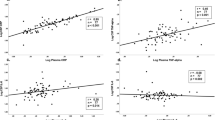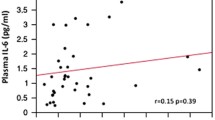Abstract
C-reactive protein (CRP), in the plasma, serves as a marker of systemic inflammation and has been shown to correlate with history of actual aggressive behavior, and as a personality trait of aggressive tendency, in human subjects. This pilot study was conducted to determine if plasma CRP levels are correlated with cerebrospinal fluid levels (CSF CRP) and if CSF CRP also correlates with aggression. If so, this would suggest a role for central inflammatory processes in human aggression. Both plasma and basal lumbar CSF samples were obtained from 17 subjects with DSM-5 personality disorder and assayed for CRP. Plasma and CSF CRP levels were correlated (r = 0.65, p = 0.005) and each correlated with aggression (Plasma: r = 0.53, p = 0.029; CSF: r = 0.84, p < 0.001). When considered simultaneously, CSF CRP, but not plasma CRP, uniquely correlated with aggression. No relationship was seen with other measures of psychopathology. These data suggest a positive relationship between central nervous system CRP and aggression in humans.


Similar content being viewed by others
Abbreviations
- BDHI:
-
Buss–Durkee Hostility Inventory
- BIS-11:
-
Barratt Impulsiveness Scale––11th version
- BMI:
-
Body mass index
- CRP:
-
C-reactive protein
- CSF:
-
Cerebrospinal fluid
- EPQ:
-
Eysenck Personality Questionnaire
- GAF:
-
Global assessment of function
- 5-HIAA:
-
5-Hydroxyindolacetic acid
- HVA:
-
Homovanillic acid
- LES:
-
Life experiences survey
- LHA:
-
Life history of aggression
- PD-NOS:
-
Personality disorder-not otherwise specified
- SES:
-
Socioeconomic status
References
American Psychiatric Association (2013) Diagnostic and statistical manual of mental disorders, 5th edn. American Psychiatric Association Press, Washington DC
Bhatt S, Bhatt R, Zalcman SS, Siegel A (2008) Role of IL-1 beta and 5-HT2 receptors in midbrain periaqueductal gray (PAG) in potentiating defensive rage behavior in cat. Brain Behav Immun 22:224–233
Brummett BH, Boyle SH, Ortel TL, Becker RC, Siegler IC, Williams RB (2010) Associations of depressive symptoms, trait hostility, and gender with C-reactive protein and interleukin-6 response after emotion recall. Psychosom Med 72:333–339
Bunce SC, Noblett KL, McCloskey MS, Coccaro EF (2005) High prevalence of personality disorders among healthy volunteers for research: implications for control group bias. J Psychiatr Res 39:421–430
Buss AH, Durkee A (1957) An inventory for assessing different kinds of hostility. J Consult Psychol 21:343–348
Coccaro EF (2006) Association of C-reactive protein elevation with trait aggression and hostility in personality disordered subjects: a pilot study. J Psychiatr Res 40:460–465
Coccaro EF, Lee R (2010) Cerebrospinal fluid 5-hydroxyindolacetic acid and homovanillic acid: reciprocal relationships with impulsive aggression in human subjects. J Neural Transm 117:241–248
Coccaro EF, Berman ME, Kavoussi RJ (1997) Assessment of life history of aggression: development and psychometric characteristics. Psychiatry Res 73:147–157
Coccaro EF, Lee R, Kavoussi RJ (2010) Aggression, suicidality, and intermittent explosive disorder: serotonergic correlates in personality disorder and healthy control subjects. Neuropsychopharmacology 35:435–444
Coccaro EF, Lee R, Coussons-Read M (2014) Elevated plasma inflammatory markers in individuals with Intermittent explosive disorder and correlation with aggression in humans. JAMA Psychiatry 71:158–165
Dantzer R, O’Connor JC, Freund GG, Johnson RW, Kelley KW (2008) From inflammation to sickness and depression: when the immune system subjugates the brain. Nat Rev Neurosci 9:46–56
Dowlati Y, Herrmann N, Swardfager W, Liu H, Sham L, Reim EK, Lanctôt KL (2010) A meta-analysis of cytokines in major depression. Biol Psychiatry 67:446–457
Eysenck HJ, Eysenck SBG (1975) Manual of the Eysenck personality questionnaire (junior and adult). Hodder and Stoughton, London
Eysenck SBG, Eysenck HJ (1977) The place of impulsiveness in a dimensional system of personality description. Br J Soc Clin Psychol 16:57–68
First MB, Spitzer RL, Gibbon M, Williams JBW (1997) Structured clinical interview for DSM-IV axis I disorders (SCID). Psychiatric Institute, Biometrics Research, New York
Fri CG, Wiesel FA, Sedvall G (1974) Simultaneous quantification of homovanillic acid and 5-hydroxyindoleacetic acid in cerebrospinal fluid by mass fragmentography. Life Sci 14:2469–2480
Hamilton M (1961) A rating scale for depression. J Neurol Neurosurg Psychiatry 23:56–62
Hassanain M, Zalcman S, Bhatt S, Siegel A (2003) Interleukin-1 beta in the hypothalamus potentiates feline defensive rage: role of serotonin-2 receptors. Neuroscience 120:227–233
Hassanain M, Bhatt S, Zalcman S, Siegel A (2005) Potentiating role of interleukin-1beta (IL-1beta) and IL-1beta type 1 receptors in the medial hypothalamus in defensive rage behavior in the cat. Brain Res 1048:1–11
Howren MB, Lamkin DM, Suls J (2009) Associations of depression with C-reactive protein, IL-1, and IL-6: a meta-analysis. Psychosom Med 71:171–186
Insel T, Cuthbert B, Garvey M, Heinssen R, Pine DS, Quinn K et al (2010) Research domain criteria (RDoC): toward a new classification framework for research on mental disorders. Am J Psychiatry 167:748–751
Marnell L, Mold C, DuClos TW (2005) C-reactive protein: ligands, receptors, and role in inflammation. Clin Immunol 117:104–111
Marsland AL, Prather AA, Petersen KL, Cohen S, Manuck SB (2008) Antagonistic characteristics are positively associated with inflammatory markers independently of trait negative emotionality. Brain Behav Immun 22:753–761
Patton JH, Stanford MS, Barratt ES (1995) Factor structure of the Barratt impulsiveness scale. J Clin Psychol 51:768–774
Pepys MB, Hirschfield GM (2003) C-reactive protein: a critical update. J Clin Investig 111:1805–1812
Pfohl B, Blum N, Zimmerman M (1997) Structured interview for DSM-IV personality: SIDP-IV. American Psychiatric Press, Washington, DC
Quan N, Banks WA (2007) Brain-immune communication pathways. Brain Behav Immun 21:727–735
Sarason I, Johnson J, Siegel J (1978) Assessing the impact of life changes: development of the life experiences survey. J Consult Clin Psychol 1978(46):932–946
Suarez EC (2004) C-reactive protein is associated with psychological risk factors of cardiovascular disease in apparently healthy adults. Psychosom Med 66:684–691
Yasojima K, Schwab C, McGeer EG, McGeer PL (2000) Human neurons generate C-reactive protein and amyloid P: upregulation in Alzheimer’s disease. Brain Res 887:80–89
Zalcman SS, Siegel A (2006) The neurobiology of aggression and rage: role of cytokines. Brain Behav Immun 20:507–514
Acknowledgments
This work was supported in part by Grants from the National Institute of Mental Health: RO1 MH 66984, RO1 MH 60836; RO1 MH 63262) (Dr. Coccaro) and a Project Pilot Grant from the University of Colorado Denver (Dr. Coussons-Read).
Conflict of interest
Dr. Coccaro reports that he is on the Scientific Advisory Board of Azevan Pharmaceuticals., Inc. and that he has stock options in Azivan Pharmaceuticals, Inc., through this role. Dr. Lee reports that he has received a research grant from Azivan Pharmaceuticals, Inc. Dr. Coussons-Read reports no real or apparent conflicts of interest.
Author information
Authors and Affiliations
Corresponding author
Rights and permissions
About this article
Cite this article
Coccaro, E.F., Lee, R. & Coussons-Read, M. Cerebrospinal fluid and plasma C-reactive protein and aggression in personality-disordered subjects: a pilot study. J Neural Transm 122, 321–326 (2015). https://doi.org/10.1007/s00702-014-1263-6
Received:
Accepted:
Published:
Issue Date:
DOI: https://doi.org/10.1007/s00702-014-1263-6




